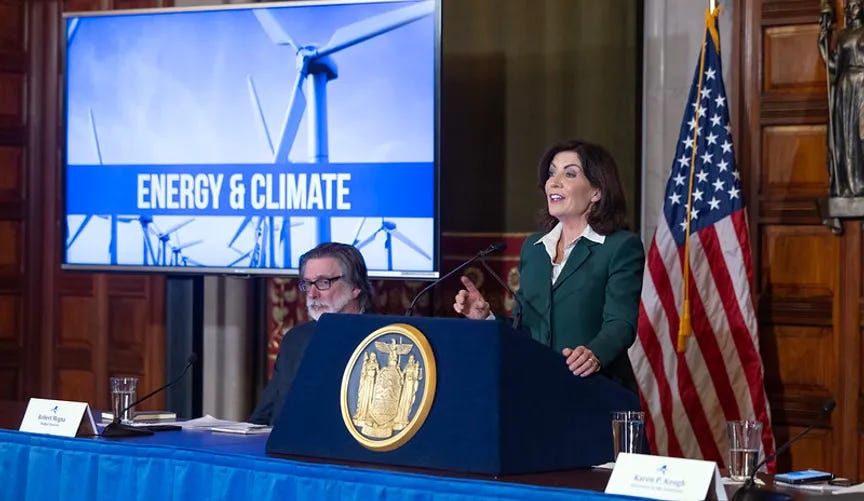The Weekly Anthropocene, May 10 2023
The global energy transition goes exponential, newly demarcated Indigenous lands in Brazil, wildlife recovery in Australia, New York passes three great climate policies, and more!
The Global Energy Transition
The Rocky Mountain Institute reports that the global transition to clean, renewable energy is in the midst of unstoppable exponential growth, across metrics from solar and wind generation to EV and battery storage scales [see chart]1.
“By 2030, renewables will dominate the sales of energy-producing and consuming technologies. The green prize will be evident. Cheap renewables will be even cheaper. Fossil fuel demand will be off the current plateau and in clear decline…
This means we must do as much as we can to narrow our time horizons and focus on speeding up the deployment of key renewables. Four technologies (solar, wind, electric vehicles, and heat pumps), in four markets (China, the United States, the European Union, and India), over the next four years, set the direction. Meanwhile it is vital for other locations and technologies to get onto a similar path.”
-Rocky Mountain Institute
Brazil

Continuing his great restoration of environmental protections and indigenous rights, Brazilian President Lula da Silva officially “demarcated” six territories as Indigenous lands, enshrining their occupants’ legal rights, and promised that more would be on the way soon. According to renowned environmental news site Mongabay, these six territories are the “Arara do Rio Amônia home of the Arara people in Acre state; Uneiuxi home of the Maku Nadёb people in the Amazon state; Avá-Canoeiro home of the Avá-Canoeiro people in Goiás state; Kariri-Xocó home of the Kariri-Xokó in the state of Alagoas; Tremembé da Barra do Mundaú home of the Tremembé people in the state of Ceará; and Rio dos Índios, home of the Kaingang people in the state of Rio Grande do Sul.”
All together, the six newly demarcated territories cover 621,800 hectares of land (about 2,400 square miles), an area larger than the American state of Rhode Island. They are home to 4,000 Indigenous people, who now have legal ownership of their ancestral territory.
This is both a long-awaited victory for oppressed peoples’ land rights, and an affirmation of one of the most effective methods of forest conservation in Brazil. Between 1990 and 2020, lands occupied by Indigenous peoples in Brazil (both formally demarcated and awaiting demarcation) lost just 1% of their forest, compared to 20.6% on privately held lands. Another study found that Indigenous lands in Brazil are some of the last parts of the forest reliably sequestering carbon dioxide, again due to Indigenous peoples’ consistently fighting deforestation.
“We are working to demarcate the highest number of Indigenous lands possible, not only because it is their right, but because if we want to reach zero deforestation by 2030, we need those lands demarcated.”
-President Lula da Silva
California
Continuing the epic story of wolves’ return to the Golden State, a trail camera in Tehama County revealed in March 2023 that California now has its fifth wolf pack2. The California Department of Fish and Wildlife has now confirmed the identification. The new Tehama Pack, consisting of at least three wolves, joins the Shasta, Lassen, Whaleback, and Beckwourth packs.
“This is incredible news for wolf recovery in California. These beautiful newcomers are proving that California has a lot of great habitat for wolves, as scientists have said all along.”
-Amaroq Weiss, Senior Wolf Advocate, Center for Biological Diversity.
New York
On May 2, 2023, after much political wrangling, the state of New York passed a $229 million budget that includes three major new climate action policies.
Fossil fuel-burning appliances (from gas stoves to water heaters furnaces) will be banned in new buildings in New York State starting in 2026, as clean electric alternatives like induction stoves and heat pumps are now widely available.
As announced in January, New York will deploy a cap-and-invest program (similar to those in California, Washington, and the EU) where there are a limited and steadily decreasing number of “permits to pollute” that large fossil fuel burning companies (natural gas utilities, factories, etc.) must pay for, providing a further financial incentive to switch to renewables. 30% of the money raised from this program will be returned to New Yorkers to offset any resulting higher costs, and the rest will go into a climate action fund to pay for more clean energy development!
The New York Power Authority, a state-owned utility, has now been instructed to close all of its fossil fuel plants by 2030 and given new authority to build and operate new solar and wind farms.
Taken together, this provides the outlines of a realistic path for the Empire State to meet its statutory goal (enacted in 2019) to reach 100% carbon-free electricity by 2040 and 85% lower greenhouse gas emissions by 2050! This legislation is also likely to serve as a “blueprint” for other blue states to follow. Spectacular news!
Australia




The World Wildlife Fund and Google deployed over 600 AI-driven cameras across Australia to monitor wildlife recovery in areas affected by the devastating bushfires of 2019-20. They found heartening signs of recovery for many animals (pictures above): detecting more threatened species than expected, recording koala survivors in the Blue Mountains, discovering unrecorded colonies of brush-tailed rock wallabies in lands formerly aflame, and a recovering population of Kangaroo Island dunnarts despite the fires recently burning almost all of their territory. Great news!
Notably, this update was written by Rocky Mountain Institute luminaries Kingsmill Bond and Sam Butler-Sloss, who The Weekly Anthropocene interviewed in 2022.
For more background on this story, check out The Weekly Anthropocene’s in-depth interview with Ms. Amaroq Weiss on wolves’ renaissance in California and across North America.







Great news from Brazil, California and New York. I live the RMI report also! My brother in law dwrarsby them! Very happy to hear the good news! Even if can't avoid climate change we can certainly make a soft landing of it, shortening it's duration, lessening it's intensity!
Hopeful stories are nice. However, the first "Climate Shock" is starting.
Last year the IPCC forecast 0.4C of warming at the peak of this El Nino.
James Hansen forecast 0.6C.
I am forecasting 0.8C.
The next 4-6 years are going to be brutally HOT and millions are about to die.
Lets see where we are after that.